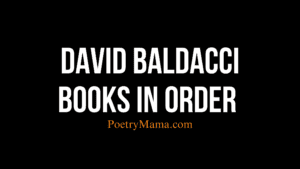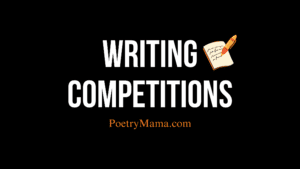Poetry writing, a common hobby for many, can be transformed into a well-established career. However, it is crucial to understand how you can publish poetry and comprehend the working of the writing community in today’s competitive world. Before you dive into the realm of finding platforms and embark on mountains of research, here we are with a proper guide to help you navigate your pathway in this bitter sweet journey as a writer in 2025.
To Always Stay Updated with PoetryMama, Follow Us On
How to Publish Poetry in 2025 (Even as a Beginner)
Prior to delving into avenues to publish poetry and identifying suitable platforms for submitting your work, it is essential to prepare the following prerequisites to streamline the process for you. Basic requirements before publishing are:
1. Cover Letter
When submitting to magazines or entering contests, it is generally mandatory to include a cover letter with your submission.
A cover letter is a formal document addressed to the Editor or publishing authority, in which the writer provides a brief bio, a summary of the submitted poem(s), and any previous accolades or awards in the field of poetry, if applicable.
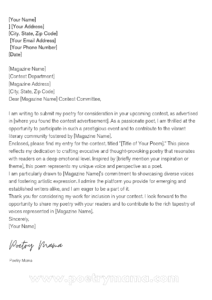
It serves as a means for the writer to express gratitude for the opportunity while also offering a space to share the background or inspiration behind the submission.
2. Document File
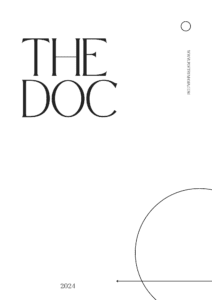
To present your work professionally, it is crucial to format your document with clear distinctions for each poem, including the title, poem number, and the poem itself. Avoid including any personal information within the document, as many submission platforms adhere to anonymous review processes to ensure impartial evaluation.
Additionally, it’s important to note that submission guidelines can vary across different publication platforms. For example, while most magazines require the cover letter to be submitted separately, some may request it to be included within the document file itself.
In short, a properly structured document is crucial and must not contain any images or visual elements until asked for.
Poems should be distributed in the Documents in following manner :
1. Doc with set of 2 – 3 poems
2. Doc with set of 5 poems
3. Individual poem docs
This is because most platforms typically request one to three poems per submission, while some may accept up to five. Therefore, having your poems prepared in advance can be both time-saving and advantageous.
3. Platform Guidelines
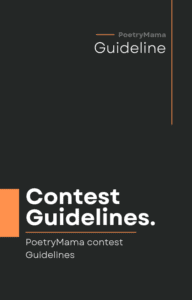
Adhering to submission guidelines is a crucial aspect of the submission process. A submission holds little value without following these instructions, as they provide essential information such as the magazine’s or contest’s theme, the allowed number of poems, deadline, eligibility criteria, citizenship requirements, file size limits, maximum number of entries, font specifications, cover letter format, contest fee details, and other mandatory details.
Furthermore, whether simultaneous submissions are permitted is explicitly stated in the submission guidelines.
4. Submittable Account Setup

Submittable is a digital platform, designed to assist in managing various types of documentation, including applications, digital forms, manuscripts, and more. Beyond organizing submissions, it also offers features to monitor their progress and effectively track their status.
In today’s literary industry, the majority of submissions are processed through Submittable. Therefore, creating an account in advance is essential to streamline the submission process and ensure a smooth, efficient experience.
Other submission platforms used by magazines for submissions are:
- WizeHive
- Foundant Technologies
- SurveyMonkey Apply
- OpenWater
- Duotroupe
That said, Submittable alone is typically adequate for managing poetry submissions, as it is widely recognized and used across the industry.
Poetry Publishing in 2025: Best Platforms, Tips & Trends
There are numerous avenues and platforms available for publishing poetry, each offering varying levels of accessibility and ease. While some provide a simple and straightforward process, others may involve more complex procedures or specific requirements.
1. Magazine & Journal Poetry Publishing

Submitting poem(s) to literary magazines, serves as a significant gateway into the literary world. A writer must carefully prepare, and submit their work through the designated submission platform of the chosen magazine. It is essential that these submissions align with the magazine’s theme and strictly adhere to its submission guidelines.
Today, numerous renowned literary magazines, offer payment ranging from $50 to $200 per accepted poem. In addition to monetary compensation, acceptance often grants automatic entry into annual contests, presenting valuable opportunities for emerging poets to build their reputation within the literary community while also gaining a measure of financial independence.
CONS of Magazine & Journal Poetry Publishing:
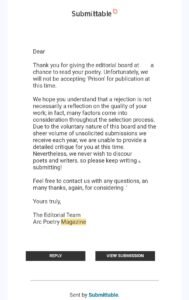
- Submitting poems to magazines can be a complex and demanding process. It often requires time, research, and careful preparation.
- Poets must be mentally prepared for rejection. Rejection is a normal part of the submission process and happens even to experienced writers.
- Rejection should not be taken personally. Many factors influence acceptance, including editorial preferences, theme fit, and timing.
- A consistent and determined approach is key to success. Sporadic or random submissions are less effective than steady, thoughtful efforts.
- Poets should research potential magazines thoroughly. Understanding a magazine’s tone, theme, and previous publications improves submission quality.
- Each submission should be tailored to the publication. Matching the poem’s style and subject matter to the magazine increases chances of acceptance.
- Creating a submission routine helps maintain momentum. Scheduling time for submissions keeps the process organized and consistent.
- Engaging with the literary community can provide encouragement. Sharing experiences and learning from others can ease the emotional burden of rejection.
- Without sustained commitment, motivation may fade over time. A lack of persistence can lead to discouragement and a halt in creative progress.
- Poets must regularly update and revise their work. Continuous improvement enhances the overall quality of submissions.
2. Poetry Publishing Contest Submissions

Submitting your poetry to contests is a traditional and effective way to get your work published. These competitions often offer prize money ranging from $100 to $1,000 or more, along with increased visibility and recognition.
Furthermore, winning a poetry contest, hosted by a reputable magazine can greatly elevate, a poet’s standing in the literary world. For emerging poets or those facing financial limitations, many contests offer free entry options. Conversely, established poets looking to strengthen their literary presence and gain further recognition often choose to enter contests that require a submission fee.
Some poetry contests, are specifically reserved for particular groups, such as Black or Indigenous individuals, undergraduate students, those under the age of 18, or people of certain nationalities. Therefore, it is strongly recommended to carefully review the eligibility criteria and guidelines before submitting your entry.
3. Manuscript
Manuscripts are a formal collection of poems bound together within a single book. Upon the completion of a manuscript, poets typically seek publication through publishing houses, literary magazines, or manuscript contests.
Once a manuscript is accepted for publication, the poet’s entire manuscript gets published. This publication can occur through traditional publishing houses, which handle the editing, printing, and distribution of the manuscript, or through literary magazines that feature selected works from various authors.
It is to be considered that only a part of your manuscript can be previously published but not the entire manuscript. In case of previous publications, rejection chances increase.
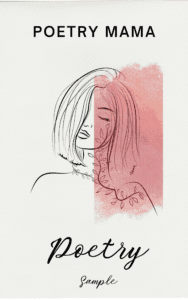
Through manuscript contests, poets gain an opportunity to earn cash prizes of $10,000 or more depending on the prestige and reputation of the contest.
Furthermore, upon selection of the manuscript in magazines, the magazines consider the poet’s work for their annual poetry prizes in manuscript writing automatically.
Overall, the publication process for manuscripts involves careful consideration of various avenues for exposure and recognition within the literary community, offering authors opportunities to showcase their work and potentially earn significant recognition and financial rewards.
4. Self Publishing
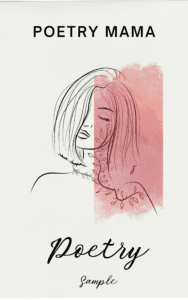
Self-publishing is a method to publish poetry with one’s own money and at one’s own expense. Poets take full control of the publishing process themselves, rather than relying on traditional publishing routes like submitting work to printing presses or literary magazines.
In self-publishing, poets compile all of their works into a single book. The process typically begins with preparing a manuscript, ensuring that it is properly formatted and edited. Next, the poet must select a suitable publishing platform, whether it be an online self-publishing service or a local printing company. Once the platform is chosen,it’s time for formatting the book for publication and designing an appropriate cover. Additionally, setting an appropriate price for the book is crucial.
Overall, self-publishing offers poets the opportunity to have full creative control over their work.
SELF PUBLISHING PLATFORMS:
- Amazon Kindle Direct Publishing
- Smashwords
- Lulu
- Ingram Spark
- Blurb
- Kobo writing life
- Barnes & Noble Press
- Wattpad
- Darft2digital
- BookBaby
- IUniverse
- Xlibris
- Author House
5. Blogging

Blogging, although a viable option for publishing poetry, often receives less attention and acclaim compared to traditional publishing avenues. This is largely due to the perception of lower recognition and prestige associated with online platforms.
For poets opting to establish a blog, there are several essential steps to undertake. These include setting up the blogging site itself, engaging in promotional activities to attract the audience, and learning about Search Engine Optimization (SEO) techniques to enhance visibility and reach. However, once these initial tasks are completed, poets encounter no obstacles in sharing their work with a global audience online.
It’s important to note that generating revenue from a poetry blog typically doesn’t occur in the initial stages. However, as the blog gains attraction and gains a dedicated readership, opportunities for revenue generation through methods such as advertising, sponsorships, or selling poetry-related products can become fruitful.
Examples of Poetry Blogs :
- The Guardian
- Poetry Foundation
- Poets & Writers
- Read A Little Poetry
- Moving Poems
- Tweet Speak Poetry
- Write Out Loud
6. Regional or National Newspaper
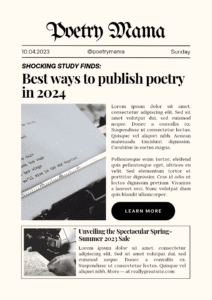
To publish poetry in a newspaper, multi-step process is involved which starts with identifying newspapers that feature sections dedicated to literature, arts, or related topics. Once suitable newspapers are identified, the poet must carefully review each publication’s submission guidelines. These guidelines typically outline specific themes, formatting preferences, word count limitations, and submission deadlines.
After thoroughly reading the submission requirements, the poet should reframe their poetry to meet the newspaper’s standards and preferences. This may involve revising the content, structure, or style of the poems to better fit the publication’s style and audience.
Once the poetry has been appropriately tailored to meet the submission guidelines, the poet can proceed to submit their work to the newspaper for consideration. Submission methods may vary depending on the publication and can include online submission portals, email, or traditional mail. It’s important to follow the specified submission instructions carefully and provide any required supporting materials, such as a brief author bio or cover letter.
After the submission is made, the poet must patiently wait for the newspaper’s response. If the poetry is accepted for publication, the newspaper’s editorial team will typically reach out to the poet to discuss any necessary revisions or edits. This collaborative editing process ensures that the final published work meets the publication’s quality standards and aligns with its editorial vision.
Once any required revisions have been made and the poetry has been finalized for publication, the poet will be asked to sign an agreement with the newspaper. This agreement may include details such as publication rights, compensation terms, and copyright ownership. Signing the agreement formalizes the relationship between the poet and the newspaper and provides legal clarity regarding the use and distribution of the published work.
In summary, the process to publish poetry in a newspaper, requires thorough research, careful adherence to submission guidelines, creative adaptation of the poetry, submission of the work for consideration, collaborative editing with the editorial team, and finalization of publication details through a formal agreement.
7. Social Media Platforms

Utilizing social media platforms for poetry publication represents one of several viable channels for showcasing literary creations. While it may not carry the same level of recognition or prestige as traditional ways, establishing a substantial audience can yield a decent income stream. The dynamics of publishing on social media platforms vary across different channels.
PROs:
- Poets with financial restraints have a better chance to promote and publish their poetry as the platforms are free or need minimal investment.
- Poets can become a part of poetry communities of different platforms where they’ll get a better chance for promotion.
- It also helps the poet to get an insight on the audience comprehension and trends within the readers.
- It provides a creative edge to the writer as they can customise their posts according to the theme and radiance of their works. Social media also provides an opportunity to digitalize traditional poetry.
- Social media has billions of users, providing the poet to have a greater audience outside its reach.
CONs:
- It does not provide the writer the same prestige and respect as traditional ways.
- The writer has to face cut throat competition and it might get overwhelming to continue posting and promotion.
- Social media is flooded with low quality poetry posts with high audience reach and it is quite hard to gain the same with high quality poetry publication and ultimately leads to shallow interactions.
- Social media provides a limited range of income and does not guarantee copyright and publication rights.
Social Platforms For Publishing Poetry:
1. Instagram
2. X
3. Tumblr
4. Meta
5. Pinterest
6. YouTube
7. Wattpad
8. DeviantArt
9. Ghost
10. AllPoetry
11. JukePop
8. Collaboration

Collaborations might not be a direct way to publish poetry nonetheless it attracts readers and increases potential for publication.
Poets often engage in collaborative endeavors with professionals of different backgrounds from other fields, including artists, photographers, models, or contributors from their own discipline, such as story writers, narrators, and voice actors. Through these partnerships, poets not only expand their audience reach but also benefit from enhanced promotion of their work. Such collaborations can be facilitated across multiple platforms, including social media apps, websites, traditional print publications such as books, journals, and magazines, among others.
Other Uncommon Ways
Poetry can also be published through non-literary ways:
1. Crowd funding platforms
2. Art galleries/ Museums
3. Merchandise
4. Film/Animations
5. Brand Collaborations
6. Gaming
7. Podcasts
8. Open mic poetry
9. Literary Festivals
10. Literally workshops
11. Virtual reality poetry experience
12. NFT platforms
13. VR Chat rooms
14. Public Poetry Installation
15. Crypto currency platforms like PO.ET, STEEMIT.
16. E- Commerce
17. Community Radio
18. Collaboration with musicians/illustrators
Conclusion – How to Publish Poetry
There are various methods to publish poetry, ranging from traditional to digital or modernized ways.
Being a novice in poetry writing can be both daunting and disheartening, as budding poets often encounter significant rejection, fostering a demotivating environment. Particularly in magazines and contests, rejections are commonplace, as these platforms must select a single piece from among thousands. Rejections are an inherent aspect of a writing career, where only those writers who are determined and focused on their goal of publishing their poetry can achieve success.
Additionally, it is crucial in this field to continuously revisit, update, and refine your work to ensure its quality.
For beginner poets, the best course of action is to participate in poetry contests that offer feedback from judges, aiding in understanding the strengths and weaknesses of their writing. Given that novice writers often have limited financial resources, it is advisable for them to seek out contests with no entry fee. Young poets often face disadvantage as they compete against recognised poets but let’s not forget that they have the boon of digital awareness. In the modern era, writers must actively promote and organize their work digitally to expand their audience and foster collaborations alongside an active participation.
In conclusion, the journey of poetry publishing often entails enduring repetitive rejections until finally achieving coveted acceptance.
TO ALWAYS STAY UPDATED WITH POETRYMAMA FOLLOW US ON:
If you liked this article, check out our other articles:



